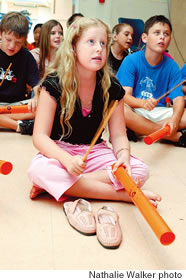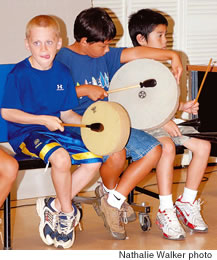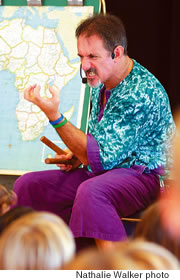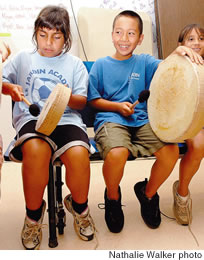Drums Instruments of Learning
Michael Wall’s Playful Percussion program teaches kids more than how to play drums. They also learn history, geography, even fractions — all while getting a real bang out of it

Hank Bley and Brian Yap pound
frame drums
When Michael Wall shouts “Rumble!” the third graders at Le Jardin happily rumble - thumping and crashing on djembe drums, frame drums, claves, bells and shakers. The vibrations rock the school’s cafeteria, leaving some exuberant smiles in their wake.
What a cool way to learn about African culture.
Wall regularly takes his van-load of African drums and other percussion instruments around to Oahu schools, using them as fun instruments for learning. He is one of a group of visiting artists trained in the education department’s Artists in the Schools program, which is sponsored by the Hawaii Alliance for Arts Education and the State Foundation on Culture and the Arts.
In his Playful Percussion lessons, Wall uses authentic instruments and rhythms from
Africa and the Caribbean to teach anything from African culture to music to fractions.
“Michael has got a great control of his audience through his voice, through his inflection so he can teach concepts while he’s got the students’ attention,” says Mike Busekrus, the teacher who organized Wall’s most recent visit to Le Jardin. “He’s very gifted.”

Georgia Heavens with a Boomwhacker
Gifted, yes. Initially a life skills facilitator, Wall has been “doing the drum thing” for about a decade and is a well-known figure on the national drumming scene. He can tell you practically anything you want to know about the West African Mande drumming style and quite a lot about Afro-Caribbean and Brazilian styles, too. Always a student, he’s now learning Middle Eastern belly dance styles.
He also has a knack with the kids.
“I think he was pretty funny,” says Le Jardin third-grader Renee van Bergeijk. “He was very interesting. He gave us a lot of information about Western Africa.”
Introducing Le Jardin students to claves (wood sticks), Wall clowns around.
“They’re horns!” he jokes, holding them on top of his head. “They’re ears! They’re fangs!”
Once they’re all giggling, Wall demonstrates how the claves are really used.
After the talk, it’s time to play. Wall gets the 66 students in a huge circle with the five Mande instruments he has introduced, and they set to it.

Michael Wall emphasizes playing
with feeling
“It sounded just like a big noise - bang, boom,” says third-grader Hank Bley, whose favorite instrument was the djembe drum.
At first it’s so much cacophony. But Wall works the circle, shouting out the different rhythms and the free-for-all knits into music - loud music.
“It was like being in a concert,” says student Lauren Hirsch. “It was really fun and exciting.”
Wall harnesses that fun to teach many different subjects and concepts. At Le Jardin, it was social studies on Africa. At Waiahole Elementary, Wall is working on a geography unit comparing Hawaiian and African cultures. At Kailua Elementary, he’s used drumming to introduce the concept of fractions. He’s done team-building exercises with student councils and sports teams. And farther afield in New Zealand, Wall incorporates drumming in a life skills and leadership program.

Mariah Holt and Brandon Ho play
frame drums
Playful Percussion includes drum circle games with clapping, dance and movement, and call-and-response singing.
“The cool thing about drumming (as a team activity) is that most people feel they have no rhythm in our culture,” Wall says. “So it’s a big leveler. Everyone is a learner.”
Nationally, drumming has been gaining in popularity, and the ancient practice is used as everything from a spiritual pathway to a corporate team-builder.
Drumming has even been shown to be good for your health. The activity can actually change a person’s brainwave
Page 1 of 2 pages for this story 1 2 >
E-mail this story | Print this page | Comments (0) | Archive | RSS
Most Recent Comment(s):








